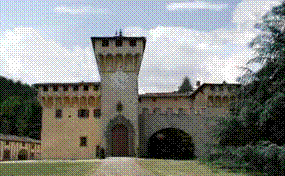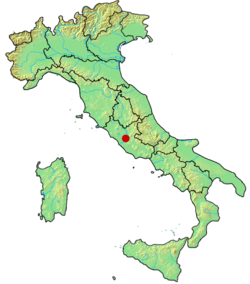
Montalcino is a hill town and comune in the province of Siena, Tuscany, central Italy.

Pope Sixtus IV was head of the Catholic Church and ruler of the Papal States from 9 August 1471 to his death, in August 1484. His accomplishments as pope included the construction of the Sistine Chapel and the creation of the Vatican Library. A patron of the arts, he brought together the group of artists who ushered the Early Renaissance into Rome with the first masterpieces of the city's new artistic age.

Ferrara is a city and comune (municipality) in Emilia-Romagna, Northern Italy, capital of the province of Ferrara. As of 2016, it had 132,009 inhabitants. It is situated 44 kilometres northeast of Bologna, on the Po di Volano, a branch channel of the main stream of the Po River, located 5 km north. The town has broad streets and numerous palaces dating from the Renaissance, when it hosted the court of the House of Este. For its beauty and cultural importance, it has been designated by UNESCO as a World Heritage Site.

Città di Castello ; "Castle Town") is a city and comune in the province of Perugia, in the northern part of Umbria. It is situated on a slope of the Apennines, on the flood plain along the upper part of the river Tiber. The city is 56 km (35 mi) north of Perugia and 104 km (65 mi) south of Cesena on the motorway SS 3 bis. It is connected by the SS 73 with Arezzo and the A1 highway, situated 38 km (23 mi) west. The comune of Città di Castello has an exclave named Monte Ruperto within Marche.

Bracciano is a small town in the Italian region of Lazio, 30 kilometres northwest of Rome. The town is famous for its volcanic lake and for a particularly well-preserved medieval castle Castello Orsini-Odescalchi. The lake is widely used for sailing and is popular with tourists; the castle has hosted a number of events, especially weddings of actors and singers.

Monselice is a town and municipality (comune) located in northeastern Italy, in the Veneto region, in the province of Padua about 20 kilometres (12 mi) southwest of the city of Padua, at the southern edge of the Euganean Hills.
Monselice is the most picturesque town I have seen in Italy. It has an old ruin of a castle upon the hill and thence commands a beautiful and extraordinary view. It lies in the wide plain – a dead level – whereon Ferrara, Bologna, Rovigo, Este, Padua stand and even Venice we could dimly see in the horizon rising with her tiara of proud towers. What a walk and what a wide delightful picture. To Venice 38 miles. Ralph Waldo Emerson Journals
The War of Ferrara was fought in 1482–1484 between Ercole I d'Este, Duke of Ferrara, and the Papal forces mustered by Ercole's personal nemesis, Pope Sixtus IV and his Venetian allies. Hostilities ended with the Treaty of Bagnolo, signed on 7 August 1484.

Girolamo Riario was Lord of Imola and Forlì. He served as Captain General of the Church under his uncle Pope Sixtus IV. He was one of the organisers of the failed 1478 Pazzi conspiracy against the Medici family, the rulers of Florence, and was assassinated 10 years later by members of the Forlivese Orsi family.

Castelfiorentino is a city and comune (municipality) in the Metropolitan City of Florence, Tuscany, central-northern Italy, halfway between Florence, Pisa (45 km) and Siena (55 km). The population is approximately 20,000 inhabitants. It is part of Valdelsa. Castelfiorentino borders the following municipalities: Certaldo, Empoli, Gambassi Terme, Montaione, Montespertoli and San Miniato.

San Casciano in Val di Pesa is a comune (municipality) in the Metropolitan City of Florence in the Italian region Tuscany, located about 15 kilometres (9 mi) southwest of Florence.

The Castello Estense or castello di San Michele is a moated medieval castle in the center of Ferrara, northern Italy. It consists of a large block with four corner towers.

The Villa Medicea di Cafaggiolo is a villa situated near the Tuscan town of Barberino di Mugello in the valley of the River Sieve, some 25 kilometres north of Florence, central Italy. It was one of the oldest and most favoured of the Medici family estates, having been in the possession of the family since the 14th century, when it was owned by Averardo de' Medici. Averardo's son, Giovanni di Bicci de' Medici, is considered to be the founder of the Medici dynasty.

The Amidei family was an ancient Italian noble family from Florence, Italy. The family was of Roman descent but lived in Florence since its foundation. They have been described by Niccolò Machiavelli as being one of the most powerful families of its time, and were featured in Dante's poems on the political struggles of the Guelphs and Ghibellines in medieval Italy. Ancestors of the House of Piccolomini, Patricians of Siena, they married into the Medici family during the 20th century. The Amidei also claimed a Julia gens ancestry, through the Cottius family, Patricians of Rome.

The Villa di Castello, near the hills bordering Florence, Tuscany, central Italy, was the country residence of Cosimo I de' Medici, Grand Duke of Tuscany (1519-1574). The gardens, filled with fountains, statuary, and a grotto, became famous throughout Europe. The villa also housed some of the great art treasures of Florence, including Sandro Botticelli's Renaissance masterpieces The Birth of Venus and Primavera. The gardens of the Villa had a profound influence upon the design of the Italian Renaissance garden and the later French formal garden.

The Villa del Trebbio is a Medici villa in Tuscany, Italy.

The palleschi, also known as bigi, were partisans of the Medici family in Florence. The name derived by the Medici coat-of-arms, bearing six 'balls' (palle).

The 1513 papal conclave, occasioned by the death of Pope Julius II on 21 February 1513, opened on 4 March with twenty-five cardinals in attendance, out of a total number of thirty-one. The Conclave was presided over by Cardinal Raffaele Sansoni Riario, who was both Dean of the College of Cardinals and Cardinal Chamberlain of the Holy Roman Church (Camerlengo). Voting began on 10 March, and there were only two Scrutinies. Negotiations after the first balloting led to the election of Cardinal Giovanni de'Medici, the son of Lorenzo the Magnificent and the de facto ruler of Florence, as Pope Leo X on the morning of 11 March.

The Pucci family has been a prominent noble family in Florence over the course of many centuries. A recent notable member of this family was Emilio Pucci, an Italian fashion designer who founded a clothing company after World War II.

Castello Orsini-Odescalchi is a castle in Bracciano, Lazio, Italy. It is located on the southern shore of Lake Bracciano. It was built in the 15th century, and combines the functions of a military defence structure and a civilian residence of the feudal lords of the period, the Orsini and Borgia, both papal families. As one of the largest and best-maintained castles in Italy, it also houses a museum; as a centre of cultural events, the Castello has hosted several high-profile weddings such as those of Tom Cruise/Katie Holmes, Eros Ramazzotti/Michelle Hunziker, and Petra Ecclestone/James Stunt.

Medici is a historical drama television series created by Frank Spotnitz and Nicholas Meyer. The series was produced by Italian companies Lux Vide and Rai Fiction, in collaboration with Frank Spotnitz's Big Light Productions.




















